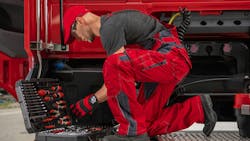This is Part Two of a two-part story.
With standard repair times (SRTs) able to help shops set technician efficiency benchmarks and maximize productvity to billing ratios, it's worth investing time into analyzing and developing SRTs for the tasks your shop handles most frequently. In Part One of this story, we discussed how shops can establish SRTs for their shop and how to skirt data overload throughout this process.
Then, once your SRT's are codified, technicians can apply new tools and telematics offerings to help technicians meet or beat established SRTs, all of which add to greater shop efficiency and decreased downtime for fleets.
Tools to streamline repairs
There are ways for shops to optimize their standard repair jobs to reduce time without cutting corners, including digitizing processes. “If you’re still using paper, not only does someone have to manually enter that data into a computer, meaning double work, but the opportunity for errors is enormous,” said Bob Hausler, VP of transport, North America, for AMCS Group.
Relying on pen and paper also means technicians spend time walking back and forth. “You might have 40 hours of work for technicians, but they aren’t turning wrenches. They’re going back and forth between bays,” said Chris O’Brien, chief operating officer for Fullbay.
Proper training to enhance technician knowledge and ensure that technicians use all available resources is important. “This can include assistance from experienced technicians, utilizing programs such as Noregon’s Technician as a Service, and accessing online material,” said DJ Painter, Technician as a Service lead for Noregon.
Iron Buffalo Truck and Trailer Repair invests in training programs and has hired a director of training.
“The most common things are done in a standard way; by doing them a standard way, you’re speeding them up,” said Mike Schwarz, co-owner of Iron Buffalo. “This is a huge investment, but we’re developing technicians, teaching them a standard way to do things, and seeing improvement in [lowering quality issues].”
Standardization also applies to how tools and equipment are stored. “You want to know where your tools are. We’re looking for a clean environment with no clutter,” Schwarz said.
The right tools can also make a job go faster. “At a certain level, you should invest in tools so your technicians can come with basic wrenches and screwdrivers, but the shop is providing the bulk of the tools,” O’Brien said.
An example of that is a $4,000 smoke machine Iron Buffalo purchased. “You inject smoke into the automobile or diesel truck, and it will seep out where there is a leak,” Schwarz said. “It is not something a mechanic is going to buy, but it helps them find something faster.”
Read more: How processes and guidelines improve repair quality
Schwarz also purchased an expensive kingpin tool that speeds the process of getting a kingpin out from eight hours to 30 minutes, and a 10-ton that can take a specific procedure down from ten hours to one.
Grouping similar repairs can optimize technicians’ time. “If you send me three clutch jobs in a row, I can be more efficient. Most clutches take the same tools,” O’Brien said.
Telematics and productivity
Shops are also turning to remote diagnostics to troubleshoot problems before vehicles arrive. “Using telematics technology, connected vehicles can transmit real-time data on engine performance, sensor readings, and fault codes,” said Kayleigh O’Malley, product marketing manager, reporting and analytics for Fleetio.
While telematics are helpful, this data can also add a lot of noise. “Many fleets don’t have the time to sort this out and therefore can’t take advantage of the benefits of getting Diagnostic Trouble Codes in real time,” Hausler said. “This is where a solid integration between your telematics and your computerized maintenance management system can really deliver value.”
Increased connectivity can help prevent common causes of repair delays, such as waiting on authorization from a customer or not having a part available, said Magnus Gustafson, VP of connected services, Volvo Trucks North America.
Volvo Connect, a comprehensive fleet management portal, provides vehicle data insights, diagnostics, remote programming, and reports through a single platform. “Before the truck arrives, it is pre-diagnosed, and there is a list of parts needed and the most likely root cause,” Gustafson said. Authorizations can take place in the portal.
Often, shops utilize a skilled mechanic who does diagnostic work or triaging and then passes the vehicle to a different mechanic. “In these cases, we’ve taken care of those diagnostics. You can take it straight to someone else to repair,” Gustafson said.
Increased connectivity also enables remote programming. “Some issues can be mitigated through software updates. We can update software remotely and not take it out of service. Keeping that truck updated prevents issues in the first place,” Gustafson said.
Noregon’s Painter said using real-time data, regularly reviewing KPIs, and implementing best practices saves everyone time. “Simply put, shops want to reduce dwell time, and fleets want to increase vehicle uptime. These goals are mutually accomplished by investing in tools, services, and processes that improve technician efficiency,” he said.

